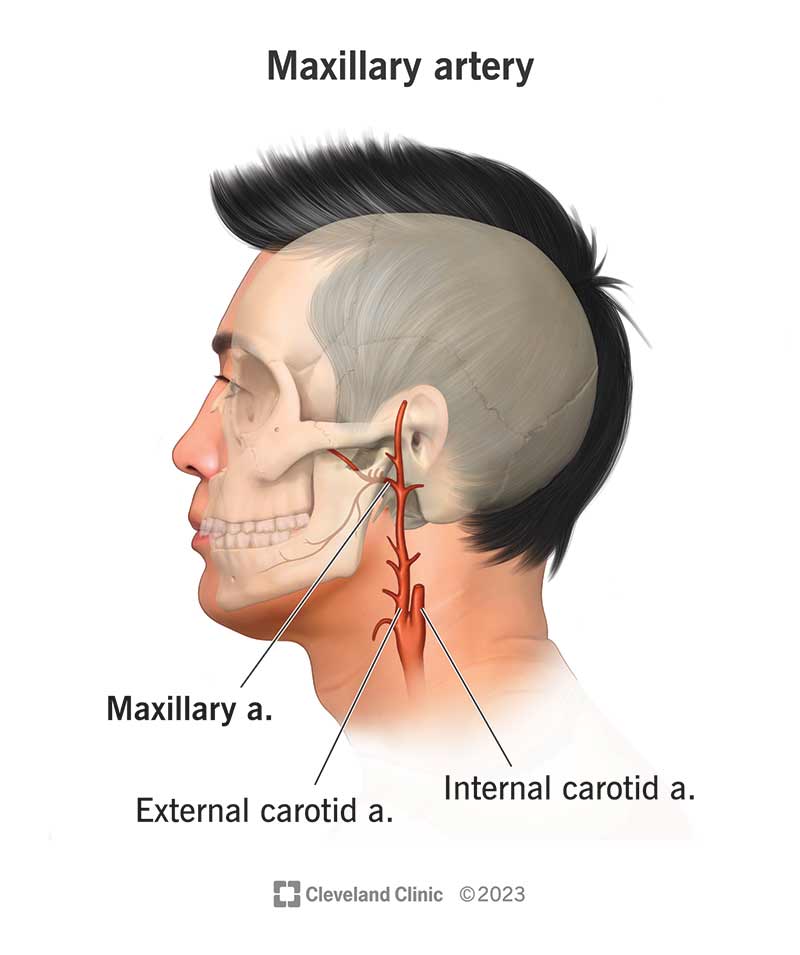Your maxillary artery supplies blood to many parts of your face, like your mouth, chin and ear. It starts in front of your ear and spreads out from there. Healthcare providers can use your maxillary artery when treating medical issues in other parts of your head.

The maxillary artery, which some people call the internal maxillary artery, is deep inside each side of your face. Many branches of your maxillary artery run up, down and across your face.
Cleveland Clinic is a non-profit academic medical center. Advertising on our site helps support our mission. We do not endorse non-Cleveland Clinic products or services. Policy
The function of the maxillary artery is to supply blood to certain parts of your face. Like all arteries, maxillary arteries bring oxygen and nutrients to your tissues and cells so they can do their jobs.
But healthcare providers also use your maxillary artery to solve certain medical problems, like:
The maxillary artery supplies blood to parts of your face, like your:
The maxillary artery branches off from the external carotid artery, which runs up and down your neck. If you think of your carotid artery as going north, your maxillary artery would branch off to the east (or west on the other side of your head) and then the north. It starts in your parotid gland, which is in front of your ear.
Your maxillary artery may run closer to, or farther from, the middle of the muscle in front of your ear. In some people, this may differ from one side of the face to the other. Also, some branches of the maxillary artery may branch off together instead of separately.
In some cases, an artery that usually branches off from a maxillary artery doesn’t — it comes from the external carotid artery instead.
The three parts of the maxillary artery are the:
The branches of the maxillary artery are the:
| In the mandibular section | In the pterygoid section | In the pterygopalatine section |
|---|---|---|
| Deep auricular artery; Anterior tympanic artery; Middle meningeal artery; Accessory meningeal artery; Inferior alveolar artery; Tympanic artery. | Deep temporal arteries (anterior, middle and posterior); Buccal artery; Masseteric artery; Pterygoid artery. | Pharyngeal artery; Greater palatine artery; Artery of the pterygoid canal; Sphenopalatine artery; Posterior superior alveolar artery; Infraorbital artery; Vidian artery. |
| In the mandibular section | ||
| Deep auricular artery; Anterior tympanic artery; Middle meningeal artery; Accessory meningeal artery; Inferior alveolar artery; Tympanic artery. | ||
| In the pterygoid section | ||
| Deep temporal arteries (anterior, middle and posterior); Buccal artery; Masseteric artery; Pterygoid artery. | ||
| In the pterygopalatine section | ||
| Pharyngeal artery; Greater palatine artery; Artery of the pterygoid canal; Sphenopalatine artery; Posterior superior alveolar artery; Infraorbital artery; Vidian artery. |
The estimated size of the maxillary artery varies by section.
| Mandibular section | Pterygoid section | Pterygopalatine section |
|---|---|---|
| 14 to 16 millimeters (.55 to .62 inches) long. | 15 to 20 millimeters (.59 to .78 inches) long. | 11 millimeters (.43 inches) long. |
| Nearly 4 millimeters (.15 inches) in diameter. | About 3 millimeters (.12 inches) in diameter. | Nearly 3 millimeters (.12 inches) in diameter. |
| Mandibular section | ||
| 14 to 16 millimeters (.55 to .62 inches) long. | ||
| Pterygoid section | ||
| 15 to 20 millimeters (.59 to .78 inches) long. | ||
| Pterygopalatine section | ||
| 11 millimeters (.43 inches) long. | ||
| Nearly 4 millimeters (.15 inches) in diameter. | ||
| Pterygoid section | ||
| About 3 millimeters (.12 inches) in diameter. | ||
| Pterygopalatine section | ||
| Nearly 3 millimeters (.12 inches) in diameter. |
Conditions that may affect your maxillary artery include:
Signs or symptoms of conditions that affect your maxillary artery include:
A provider can see the maxillary artery with imaging tests, like:
Your provider may also perform a physical examination to assess for signs and symptoms of maxillary artery dysfunction.
Treatments for your maxillary artery may include:
You can keep your maxillary artery healthy by following these tips:
A note from Cleveland Clinic
Well below your skin, your maxillary artery is sending blood to the muscles and tissues in your face. A healthy lifestyle helps you care for all of your blood vessels. Regular checkups with a healthcare provider can help ensure that all is well with your cardiovascular (heart and blood vessel) system. A provider can catch issues early before they become harder to treat.
Last reviewed by a Cleveland Clinic medical professional on 05/30/2023.
Learn more about our editorial process.
Cleveland Clinic is a non-profit academic medical center. Advertising on our site helps support our mission. We do not endorse non-Cleveland Clinic products or services. Policy